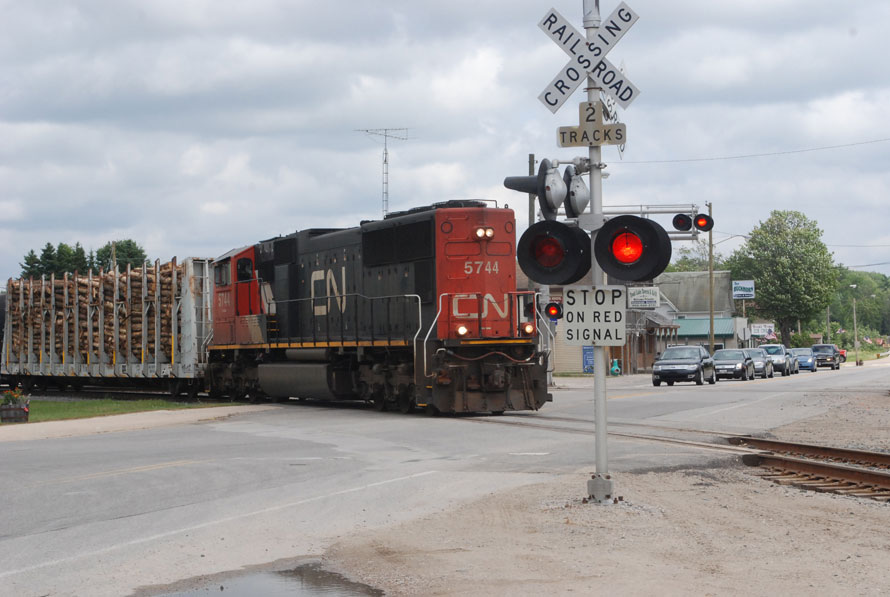
I cross the Big Mac into the Upper Peninsula, paying four dollar for the privilege at the St. Ignace toll booth. A few miles north of St. Ignace, I leave the freeway, taking Michigan 123 into the heart of the Upper Peninsula. The road follows the former roadbed of the Duluth, South Shore and Atlantic Railroad which Ernest Hemingway rode a few years after the Great War as he and his friends headed to a fish camp along the East Branch of the Fox River outside of Seney, Michigan. That adventure provided fodder for his classic short story, “Big Two Hearted River.” In those days, one had to cross the Straits of Mackinac by ferry, but in 1957 the bridge opened, spanning the straits.
It’s late afternoon on a hot July day when I reach Trout Lake. There is a small IGA here with wonderful sandwiches, piled high with sliced meats. As I plan to have dinner with friends in Marquette, I avoid the temptation and order a cone of hand-dipped black cherry ice cream. As I wait on the clerk, I look around the store for a minute. In addition to groceries and a deli, they have fishing gear and some hardware. It seems to be a place from the past, which is why I like stopping here.
As I step outside with my cone, the bells of the railroad crossing are clanging. I walk around the building to watch a CN engine pulling a mixed assortment of log and tank cars in from the Sault. The engineer stops at the wye, just shy of the road crossing. The brakeman steps off, unlocks and turns the switch. The train then proceeds, its diesels rumbling and the cars swaying. The short train moves through the junction and across the highway, taking the tracks that continue toward Seney and eventually the paper mill at Munising. I watch it rumble down the tracks for a few minutes, then get back in my truck and continue driving west.
I’ve stopped at Trout Lake many times, but have never lingered more than a few minutes. I like the area as it reminds me of small towns in the American west. And the IGA is always a treat with its wonderful ice cream and homemade sandwiches. There’s a nice lake here but I’ve only seen it from the road. Today, this area seems so isolated, mainly a place for fishermen on the lake to replace tackle or buy beer and for snowmobilers in winter to race through on their cross-country runs across the Upper Peninsula. It’s not always been this laid back.
One hundred years ago, Trout Lake was a small but bustling community at the crossroads of the Eastern Upper Peninsula. The Duluth, South Shore and Atlantic Railroad that ran across the South Shore of Lake Superior crossed the Soo Tracks here as it headed toward St. Ignace. The Soo ran from Ontario, through Sault Ste. Marie and past Trout Lake to Naubinway and along the North Shore of Lake Michigan through Manistique, Gladstone, into Wisconsin and eventually to Minneapolis. Today, the old Duluth line only runs from this point to Munising, mainly servicing a paper mill and a lumber yard. The old Soo line is still intact, but the track weight is light as is the amount freight along the line. Over the years these railroads have gone by a number of names and an equal number of owners. Today, they’re operated by the Wisconsin Central (it’s an old name but a new corporation that handles a collection of lines owned by the Canadian National). Sadly, the Duluth and Boston Express and other passenger trains along this line stopped running long before my birth.
I drive west, crossing the tracks of the old Duluth, South Shore and Atlantic several times as I head across the Upper Peninsula on Michigan 28, passing through the quiet towns of McMillan, Seney, Shingleton and Munising, and on to Marquette.
Jeff Garrison – Photograph and text Copyright 2018
I love this little town also❤️ My son bought a cabin that he rents out by the night or week that sits right along the tracks.
I am a resident of Trout Lake and a genealogist and history buff. We are organizing a Historical Society for our Township and will be opening a museum in one of the old churches that was given to the township. Your article would make a great addition to the info we are gathering for our displays.